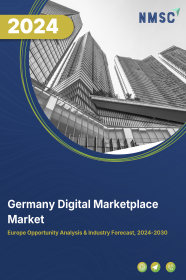
Germany Digital Marketplace Market by Product/Service Type (Physical Goods, Digital Goods, Services, and Event & Ticket Sales), by Platform (Desktop, Mobile, and Tablets), by Model Type (Business to Business (B2B), Business to Consumer (B2C), and Consumer to Consumer (C2C)), and by End Users (Commercial, and Personal) - Opportunity Analysis and Industry Forecast, 2024 – 2030.
Industry: ICT & Media | Publish Date: 22-Aug-2025 | No of Pages: 159 | No. of Tables: 120 | No. of Figures: 65 | Format: PDF | Report Code : IC2240
Germany Digital Marketplace Market Overview
The Germany Digital Marketplace Market size was valued at USD 14.14 billion in 2023, and is predicted to reach USD 20.80 billion by 2030, at a CAGR of 5.5% from 2024 to 2030. Digital marketplaces, also known as online marketplaces or digital commerce platforms, function as virtual hubs where individuals interested in buying or selling goods, services, or information come together to engage in transactions. Serving as intermediaries, these platforms facilitate interactions among various parties, including buyers and sellers, within a centralized online environment tailored for effortless product discovery, purchasing, and delivery. Well-known examples of online marketplaces include prominent e-commerce platforms including Amazon, eBay, and Alibaba, as well as service-oriented platforms such as Upwork and Fiverr.
Utilizing sophisticated technology, these platforms streamline transaction processes, ensuring rapid and secure payment processing while safeguarding the financial details of all participants involved. Moreover, they enhance user experiences by offering features such as customer reviews, ratings, and mechanisms for addressing transaction-related issues. Consequently, online marketplaces leverage technology to enhance the overall online commerce experience, making it more convenient and secure for both buyers and sellers. They play an essential role in the modern economy by bridging the gap between businesses and consumers across geographical boundaries, thereby facilitating seamless and convenient global commerce.
Population Growth and Widespread Internet Access Propel Germany's Digital Marketplace Expansion
Germany continues to be one of the leading forces in Europe’s digital marketplace ecosystem, driven by its large, tech-savvy population and near-universal internet penetration. With over 83 million residents and more than 95% of households connected to the internet, the country presents a robust consumer base for digital commerce platforms. This level of connectivity ensures that a majority of the population can easily access online services, enabling seamless engagement with e-commerce platforms, service marketplaces, and digital content providers.
The synergy between demographic stability and digital accessibility is fostering a surge in online consumer activity. As shopping habits increasingly shift toward digital formats, both local and global companies are competing to capture a growing online audience in Germany. This environment encourages rapid innovation and diversification of digital marketplace offerings, pushing platforms to enhance functionality, improve personalization, and expand service portfolios to meet evolving consumer expectations
Germany’s Government-Led Digitalization Efforts Fuel Marketplace Adoption
The German government’s ongoing push for digital transformation is significantly bolstering the growth of the country's digital marketplace sector. In 2024, the Federal Government reaffirmed its commitment to a comprehensive International Digital Policy, which aims to strengthen Germany’s leadership in digital innovation while fostering an inclusive and secure digital economy. This strategy encourages businesses and consumers alike to embrace digital commerce platforms for everyday transactions and long-term business operations.
Public-sector initiatives are providing structural support to accelerate marketplace adoption—through financial incentives, digital literacy programs, and infrastructure investment. These efforts create favorable conditions for businesses to transition to digital models and leverage online platforms for sales, procurement, and service delivery. As government-backed digitalization accelerates, Germany’s digital marketplaces are poised to grow even further, integrating new technologies such as AI-driven personalization, real-time payments, and enhanced user interfaces to accommodate increasing consumer demand.
Germany Digital Marketplace Growth Faces Constraints from Cybersecurity Threats and Consumer Trust Concerns
The expansion of Germany's digital marketplace sector is increasingly constrained by rising cybersecurity threats and growing concerns over consumer trust. As users become more aware of potential vulnerabilities—such as data breaches, identity theft, and financial fraud—they show greater reluctance to share personal information or engage in online transactions, fearing privacy violations or monetary loss.
This erosion of trust hampers user engagement across digital platforms in Germany, reducing the frequency and volume of online purchases. Additionally, incidents involving data leaks or fraudulent activities can severely damage the reputation of digital marketplaces, discouraging both consumers and businesses from participating. Without robust cybersecurity frameworks and transparent data protection practices, the long-term growth potential of Germany's digital marketplace ecosystem remains at risk.
Integration of AR and VR Technologies Presents a Promising Opportunity for Germany’s Digital Marketplace Sector
Germany’s digital marketplace sector is poised to benefit significantly from the integration of Augmented Reality (AR) and Virtual Reality (VR) technologies. These immersive tools offer German consumers a more engaging shopping experience by allowing them to visualize products in real-world settings, explore interactive virtual showrooms, and virtually try items before purchase. Such capabilities not only enhance decision-making and reduce return rates but also strengthen user confidence and satisfaction.
For businesses operating in Germany, AR and VR create new avenues to differentiate offerings in a competitive online landscape. By delivering personalized recommendations and showcasing products through interactive, data-rich formats, companies can drive higher engagement and conversion rates. As digital commerce continues to evolve in Germany, the adoption of AR and VR technologies represents a transformative opportunity to elevate customer experience and fuel long-term growth in the online retail environment
Competitive Landscape
The key players operating in the Germany digital marketplace industry include Amazon.de, eBay.de, Otto Market (Otto.de), Zalando, Temu, Etsy, Kaufland.de, Galaxus, MediaMarkt.de, AliExpress, ManoMano, Hood.de, Shpock, Yatego, Avocadostore.de and others.
Germany Digital Marketplace Market Key Segments
By Product/Service Type
-
Physical Goods
-
Electronics
-
Clothing
-
Food
-
Furniture
-
Handbag & Accessories
-
Others
-
-
Digital Goods
-
Software
-
E-Books
-
Music & Videos
-
Games
-
-
Services
-
Freelancing
-
Education
-
Consultations
-
Others
-
-
Event & Ticket Sales
By Platform
-
Desktop
-
Mobile
-
Tablets
By Model Type
-
Business to Business (B2b)
-
Business to Consumer (B2c)
-
Consumer-to-Consumer (C2c)
By End User
-
Commercial
-
Personal
Key Players
-
Amazon.de
-
eBay.de
-
Otto Market (Otto.de)
-
Zalando
-
Temu
-
Etsy
-
Kaufland.de
-
Galaxus
-
MediaMarkt.de
-
AliExpress
-
ManoMano
-
Hood.de
-
Shpock
-
Yatego
-
Avocadostore.de
REPORT SCOPE AND SEGMENTATION:
|
Parameters |
Details |
|
Market Size in 2023 |
USD 14.14 Billion |
|
Revenue Forecast in 2030 |
USD 20.80 Billion |
|
Growth Rate |
CAGR of 5.5 % from 2024 to 2030 |
|
Analysis Period |
2023–2030 |
|
Base Year Considered |
2023 |
|
Forecast Period |
2024–2030 |
|
Market Size Estimation |
Billion (USD) |
|
Growth Factors |
|
|
Companies Profiled |
15 |
|
Market Share |
Available for 10 companies |
|
Customization Scope |
Free customization (equivalent up to 80 working hours of analysts) after purchase. Addition or alteration to country, regional, and segment scope. |
|
Pricing and Purchase Options |
Avail customized purchase options to meet your exact research needs. |

















 Speak to Our Analyst
Speak to Our Analyst
























